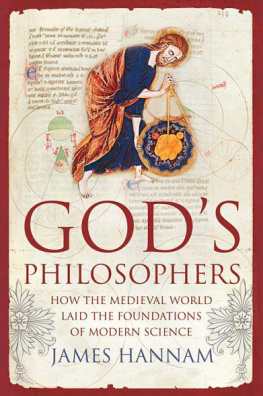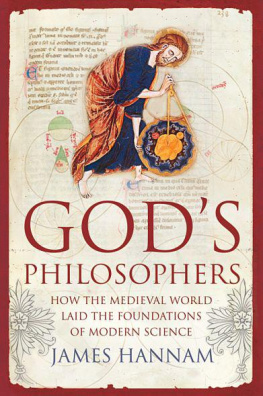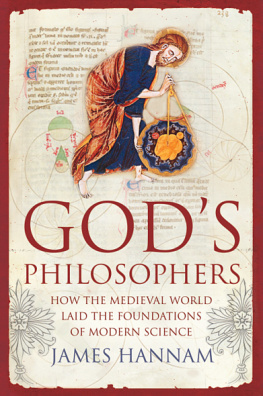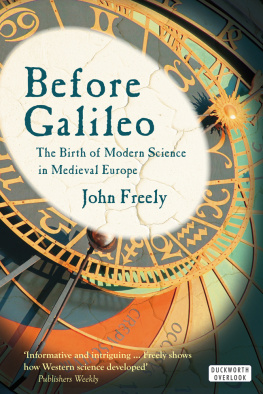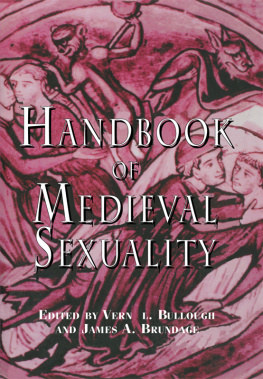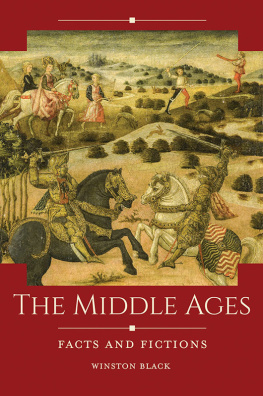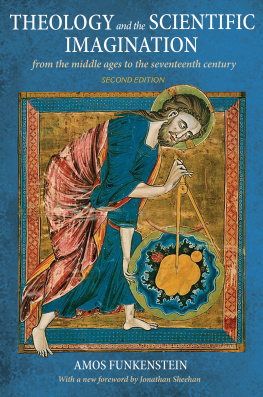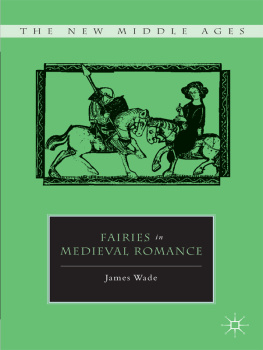
the genesis of
science
the genesis of
science
the genesis of
science
H o w t H e C H r i s t i a n M i d d l e a g e s l a u n C H e d t H e s C i e n t i f i C r e v o l u t i o n james hannam
Copyright 2011 by James Hannam All rights reserved. No part of this publication may be reproduced or transmitted in any form or by any means electronic or mechanical, including photocopy, recording, or any information storage and retrieval system now known or to be invented, without permission in writing from the publisher, except by a reviewer who wishes to quote brief passages in connection with a review written for inclusion in a magazine, newspaper, broadcast, or website.
Cataloging-in-Publication data on file with the Library of Congress ISBN 978-1-59698-155-3
Published in the United States by
Regnery Publishing, Inc.
One Massachusetts Avenue, NW
Washington, DC 20001
www.regnery.com
Originally published in the UK in 2009 by Icon Books Ltd 2nd edition published in the UK in 2010 by Icon Books Ltd, Omnibus Business Centre, 3941 North Road, London N7 9DP
This is the first Regnery edition published in 2011
Manufactured in the United States of America 10 9 8 7 6 5 4 3 2 1
Books are available in quantity for promotional or premium use. Write to Director of Special Sales, Regnery Publishing, Inc., One Massachusetts Avenue NW, Washington, DC 20001, for information on discounts and terms or call (202) 216-0600.
Distributed to the trade by:
Perseus Distribution
387 Park Avenue South
New York, NY 10016
To Vanessa
contents
List of Illustrations:
ix
Map of medieval Europe:
xxi
Introduction: The Truth about Science in the Middle Ages xiii
Chapter 1: After the Fall of Rome: Progress in the Early Middle Ages
Chapter 2:
The Mathematical Pope
Chapter 3:
The Rise of Reason
Chapter 4: The Twelfth-Century Renaissance 53
Chapter 5: Heresy and Reason
Chapter 6: How Pagan Science Was Christianized 83
Chapter 7: Bloody Failure: Magic and Medicine in the Middle Ages
Chapter 8: The Secret Arts of Alchemy and Astrology 113
Chapter 9: Roger Bacon and the Science of Light 129
Chapter 10: The Clockmaker: Richard of Wallingford 147
Chapter 11: The Merton Calculators 161
Chapter 12: The Apogee of Medieval Science 177
Chapter 13: New Horizons
Chapter 14: Humanism and the Reformation 209
Chapter 15: The Polymaths of the Sixteenth Century 229
Chapter 16: The Workings of Man: Medicine and Anatomy 247
Chapter 17: Humanist Astronomy and Nicolaus Copernicus 267
Chapter 18:
Reforming the Heavens
Chapter 19: Galileo and Giordano Bruno 303
Chapter 20: Galileo and the New Astronomy 317
Chapter 21: The Trial and Triumph of Galileo 329
Conclusion: A Scientific Revolution?
Suggestions for Further Reading
Timeline
List of Key Characters
Notes
Bibliography of Works Cited
Acknowledgements
Index
List of iLLustrations
1. Ottoman astrolabe from the Muse de lInstitut du Monde Arabe, Paris, 21
2. Map from Isidore of Seville, Etymologiae (Augsburg: Gnther Zainer, 1472), 29
3. Diagram of the universe from Peter Apian, Cosmographia (Antwerp: Arnold Berckmann, 1539), 32
4. Manuscript illumination by Laurentius de Voltolina from the Kupfer-stichkabinett, Staatliche Museen zu Berlin, 45
5. Manuscript illumination from Bible Moralisee, Vienna, sterreichische Nationalbibliothek, MS Codex Vindobonensis 2554, 59
6. Manuscript initial from Johannitius, Isagoge, Bethesda MA, National Library of Medicine, MS DeRicci [78], 107
7. Photograph of a large trebuchet, 132
8. Eastern and western Arabic numerals compared to modern western numerals, 153
9. Diagram from Nicole Oresmes De configurationibus qualitatum, Florence, Biblioteca Nazionale Centrale, MS Conv. Soppr. J. IX. 26, 184
10. A map of the world from Ptolemy, Geographia (Ulm: Leonard Hol, 1482), 198
11. Woodcut from Johannes de Ketham, Fasiculo de medicina (Venice: Zuane
& Gregorio di Gregorii, 1494), 254
12. Woodcut of a standing flayed figure from the studio of Titian in Andreas Vesalius, De fabrica corporis humanis (Basle: Joannes Oporinus, 1543), 257
13. A woodcut of a uterus from Vesalius, De fabrica, 259
14. Model of the universe from Johannes Kepler, Mysterium cosmographicam (Tbingen: Georgius Gruppenbachius, 1596), 293
15. A diagram from Galileo Galilei, trans. Henry Carew and Alfonso de Salvio, Dialogues Concerning Two New Sciences (New York: Macmillan, 1914), 337
16. A diagram from William Heytesbury, Regule solvendi sophismata (Venice: Bonetus Locatellus, 1494), 339
Gods Philosophers Map 4/6/09 15:16 Page 1
Map of Medieval Europe
Gods Philosophers Map 4/6/09 15:16 Page 1
Gods Philosophers Map 4/6/09 15:16 Page 2
in t roduC t ion
the truth about
science in the
middLe ages
the most famous remark made by Sir Isaac Newton (16421727) was: If I have seen a little further then it is by standing on the shoulders of giants.1 Most people assume that he meant his scientific achievements were built on the discoveries of his predecessors.
In the same letter, he alludes to Ren Descartes (15961650), the French philosopher and mathematician, so presumably he was one of Newtons giants. Few people realize, however, that Newtons aphorism was first coined in the twelfth century by the theologian Bernard of Chartres (who died around 1130).2 Even fewer are aware that Newtons science also has its roots embedded firmly in the Middle Ages. This book will show just how much of the science and technology that we now take for granted has medieval origins.
The achievements of medieval science are so little known today that it might seem natural to assume that there was no scientific progress at all during the Middle Ages. The period has received bad press for a long xiii
xiv
introduction
time. Writers use the adjective medieval as a synonym for brutality and uncivilized behavior. Recently, the word has affixed itself to the Taliban of Afghanistan, whom commentators routinely describe as throwbacks to the Middle Ages, if not the Dark Ages. Even historians, who should know better, still seem addicted to the idea that nothing of any consequence occurred between the fall of the Roman Empire and the Renaissance. In 1988, Daniel Boorstins history of science The Discoverers referred to the Middle Ages as the great interruption to mankinds progress. William Manchester, in his 1993 book A World Lit Only by Fire, described the period as a mlange of incessant warfare, corruption, lawlessness, obsession with strange myths and an almost impenetrable mindlessness. Charles Freeman wrote in The Closing of the Western Mind (2002) that this was a period of intellectual stagnation. He continued, It is hard to see how mathematics, science, or their associated disciplines could have made any progress in this atmosphere.3
Closely coupled to the myth that there was no science worth mentioning in the Middle Ages is the belief that the Church held back what meager advances were made. The idea that there is an inevitable conflict between faith and reason owes much of its force to the work of nineteenth century propagandists such as the Englishman Thomas Huxley (1825
Next page


